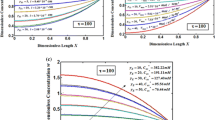Abstract
Closed-loop insulin delivery system works on pH modulation by gluconic acid production from glucose, which in turn allows regulation of insulin release across membrane. Typically, the concentration variation of gluconic acid can be numerically modeled by a set of non-linear, non-steady state reaction diffusion equations. Here, we report a simpler numerical approach to time and position dependent diffusivity of species using finite difference and differential quadrature (DQ) method. The results are comparable to that obtained by analytical method. The membrane thickness directly determines the concentrations of the glucose and oxygen in the system, and inversely to the gluconic acid. The advantage with the DQ method is that its parameter values need not be altered throughout the analysis to obtain the concentration profiles of the glucose, oxygen and gluconic acid. Our work would be useful for modeling diabetes and other systems governed by such non-linear and non-steady state reaction diffusion equations.




Similar content being viewed by others
References
Abdekhodie MJ, Wu XY (2009) Modeling of a glucose sensitive composite membrane for closed-loop insulin delivery. J Membr Sci 335:21–31
Rajendran L, Bieniasz L (2013) Analytical expressions for the steady-state concentrations of glucose, oxygen and gluconic acid in a composite membrane for closed-loop insulin delivery. J Membr Biol 246(2):121–129
Yu J, Zhang Y, Ye Y, DiSanto R, Sun W, Ranson D, Ligler FS, Buse JB, Gu Z (2015) Microneedle-array patches loaded with hypoxia-sensitive vesicles provide fast glucose-responsive insulin delivery. Proc Natl Acad Sci 112(27):8260–8265
Bae YH, Kim SW (1993) Hydrogel delivery systems based on polymer blends, block co-polymers or interpenetrating networks. Adv Drug Deliv Rev 11(1):109–135. doi:10.1016/0169-409X(93)90029-4
Wu X, Zhang Q, Arshady R (2003) Stimuli sensitive hydrogels. Polymer structure and phase transition. Polymeric biomaterials Citus Books, London, pp 157–194
Wu X, Zhang Q, Arshady R (2003) Stimuli sensitive hydrogels. Response and release modulation. Polymeric biomaterials. Citus Books, London, pp 195–231
He J-H (1999) Homotopy perturbation technique. Comput Methods Appl Mech Eng 178(3):257–262
Adomian G (1984) Convergent series solution of nonlinear equations. J Comput Appl Math 11(2):225–230
Adomian G, Witten M (1994) Computation of solutions to the generalized Michaelis–Menton equation. Appl Math Lett 7(4):45–48
Rida S (2010) Approximate analytical solutions of generalized linear and nonlinear reaction–diffusion equations in an infinite domain. Phys Lett A 374(6):829–835
He J-H (2002) Modified Lindstedt–Poincare methods for some strongly non-linear oscillations: Part I: expansion of a constant. Int J Non-Linear Mech 37(2):309–314
He J-H (2006) Some asymptotic methods for strongly nonlinear equations. Int J Mod Phys B 20(10):1141–1199
Shou D-H, He J-H (2007) Application of parameter-expanding method to strongly nonlinear oscillators. Int J Nonlinear Sci Numer Simul 8(1):121–124
Bellman RE, Roth RS (1979) A scanning technique for systems identification. J Math Anal Appl 71(2):403–411. doi:10.1016/0022-247X(79)90200-2
Bellman R, Kashef B, Vasudevan R (1974) The inverse problem of estimating heart parameters from cardiograms. Math Biosci 19(3):221–230. doi:10.1016/0025-5564(74)90040-6
Hu LC, Hu C-R (1974) Identification of rate constants by differential quadrature in partly measurable compartmental models. Math Biosci 21(1):71–76
Mingle JO (1977) The method of differential quadrature for transient nonlinear diffusion. J Math Anal Appl 60(3):559–569
Civan F, Sliepcevich C (1983) Solution of the Poisson equation by differential quadrature. Int J Numer Meth Eng 19(5):711–724
Civan F, Sliepcevich CM (1983) Application of differential quadrature to transport processes. J Math Anal Appl 93(1):206–221. doi:10.1016/0022-247X(83)90226-3
Civan F (1993) Comments on application of generalized differential quadrature to solve two-dimensional incompressible Navier–Stokes equation by C. Shu and B. E. Richards. Int J Numer Methods Fluids 17:921–922
Shu C, Richard B (1992) Parallel simulation of incompressible viscous flows by generalized differential quadrature. Comp Syst Eng 3(1–4):271–281
Shu C, Richards BE (1992) Application of generalized differential quadrature to solve two dimensional incompressible Navier–Stokes equations. Int J Numer Meth Fluids 15(7):791–798
Quan J, Chang C (1989) New insights in solving distributed system equations by the quadrature method—I. Analysis. Comput Chem Eng 13(7):779–788
Quan J, Chang C-T (1989) New insights in solving distributed system equations by the quadrature method—II. Numerical experiments. Comput Chem Eng 13(9):1017–1024
Malik M, Civan F (1995) A comparative study of differential quadrature and cubature methods vis-à-vis some conventional techniques in context of convection–diffusion–reaction problems. Chem Eng Sci 50(3):531–547
Gutierrez R, Laura P (1994) Solution of the Helmholtz equation in a parallelogrammic domain with mixed boundary conditions using the differential quadrature method. J Sound Vib 178(2):269–271
Civan F, Sliepcevich C (1984) On the solution of the Thomas–Fermi equation by differential quadrature. J Comput Phys 56(2):343–348
Civan F, Sliepcevich C (1984) Differential quadrature for multi-dimensional problems. J Math Anal Appl 101(2):423–443
Malik M, Bert C, Kukreti A (1970) Differential quadrature solution of uniformly loaded circular plate resting on elastic half-space. WIT Trans Eng Sci 1:385–396
Chen W (1996) Differential quadrature method and its applications in engineering. Department of Mechanical Engineering, Shanghai Jiao Tong University, Shanghai
Joy RA, Rajendran L (2012) Mathematical modelling and transient analytical solution of a glucose sensitive composite membrane for closed-loop insulin delivery using he’s variational iteration method. Int Rev Chem Eng 4:516–523
Bert CW, Malik M (1996) Differential quadrature method in computational mechanics: a review. Appl Mech Rev 49(1):1–28
van Stroe-Biezen S, Everaerts F, Janssen L, Tacken R (1993) Diffusion coefficients of oxygen, hydrogen peroxide and glucose in a hydrogel. Anal Chim Acta 273(1–2):553–560
Acknowledgements
The work is supported by a research Grant the Science and Engineering Board, Department of Science and Technology (DST) under the DST Centre for Mathematical Biology.
Author information
Authors and Affiliations
Corresponding author
Ethics declarations
Conflict of interest
The authors have no competing interests.
Electronic supplementary material
Below is the link to the electronic supplementary material.
Rights and permissions
About this article
Cite this article
Mukherjee, S.B., Datta, D., Raha, S. et al. Numerical simulation of a glucose sensitive composite membrane closed-loop insulin delivery system. Bioprocess Biosyst Eng 40, 1453–1462 (2017). https://doi.org/10.1007/s00449-017-1803-1
Received:
Accepted:
Published:
Issue Date:
DOI: https://doi.org/10.1007/s00449-017-1803-1




